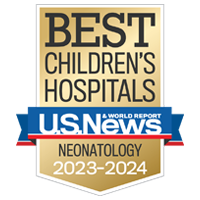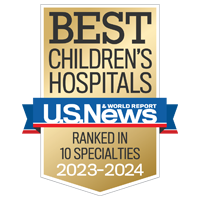Smell the roses
Wander outside into our Butterfly Garden in Oakland and our healing gardens at Mission Bay.


Omphalocele is an abdominal wall defect, similar to gastroschisis. In both gastroschisis and omphalocele, the muscles of the abdominal wall don't form correctly while the fetus is growing, allowing some of the organs — stomach, liver or intestine — to protrude outside the fetus's body. In omphalocele, the organs are contained in a thin, membranous sac. In gastroschisis, they float in the amniotic fluid.
Omphalocele may be noticed during a prenatal ultrasound. Usually the doctor performing the ultrasound sees a bump on the outside of the abdominal wall. Ultrasound can be used to determine the size of the defect as well as which organs are affected. The mother will not experience any unusual symptoms during the pregnancy.
To request an appointment, call the Fetal Treatment Center.
The child's outcome depends on the size of the omphalocele and the presence of other defects, particularly chromosome abnormalities. Fetuses with small or medium-sized omphaloceles and no other problems do extremely well with surgical repair after birth. Small omphaloceles are easily repaired with a simple operation and a short stay in the hospital nursery.
If there are other abnormalities, particularly chromosomal defects, the outcome generally depends on the severity of the other problems and not necessarily the omphalocele itself. However, fetuses with very large or so-called "giant" omphaloceles, even when not associated with other problems, have a very challenging time after birth. Most will survive with a series of difficult operations to return the organs to the abdomen and close the abdominal wall.
Large omphaloceles may require staged repair over many weeks in the hospital nursery. Giant omphaloceles require complex reconstruction over weeks, months or even years. A few of these babies will be left with life-long problems, including breathing and feeding difficulties.
Tests are needed to determine the following:
Three tests are necessary to accurately assess an omphalocele:
Omphalocele is monitored via ultrasound during the pregnancy. The schedule of ultrasound monitoring is decided on an individual basis. It's usually not necessary to have ultrasounds more than once a month, unless something is changing.
Babies with small omphaloceles and no other defects can be delivered normally and full-term, in a center with pediatric surgeons available. Babies with very small omphaloceles can be safely transported for repair elsewhere, but most will benefit from repair shortly after birth in the same unit.
Large and giant omphaloceles should be delivered at a high-level tertiary center with pediatric surgery expertise and very good neonatology support. These babies often require prolonged respiratory support during hospitalization. Often, babies with large omphaloceles are delivered by Caesarean section to minimize the risks to the baby and the mother. You and your obstetrician will determine your delivery plans.
Soon after birth, your child will have surgery to close the opening in the abdominal wall and return the organs to the abdomen. The pediatric surgeon will attempt to close the hole during this surgery, but sometimes this is not possible.
Extremely large omphaloceles are not surgically repaired until the baby grows. They are treated by placing painless drying agents on the omphalocele membrane.
Babies may stay in the hospital anywhere from one week to months after surgery, depending on the size of the defect. The baby's ability to tolerate feedings and breathe without assistance will determine the length of the hospital stay. Babies are discharged from the hospital when they are taking all their feedings by mouth and gaining weight.
After discharge from the hospital, your baby is at risk for bowel obstruction due to scar tissue or a kink in a loop of bowel. Symptoms of bowel obstruction include:
If any of these symptoms occur, contact your pediatrician immediately.
UCSF Benioff Children's Hospitals medical specialists have reviewed this information. It is for educational purposes only and is not intended to replace the advice of your child's doctor or other health care provider. We encourage you to discuss any questions or concerns you may have with your child's provider.

Top 10 in the nation for neonatology

Ranked among the nation's best in 10 specialties

successful open fetal surgery in the world

in number of fetal surgery clinical trials
Smell the roses
